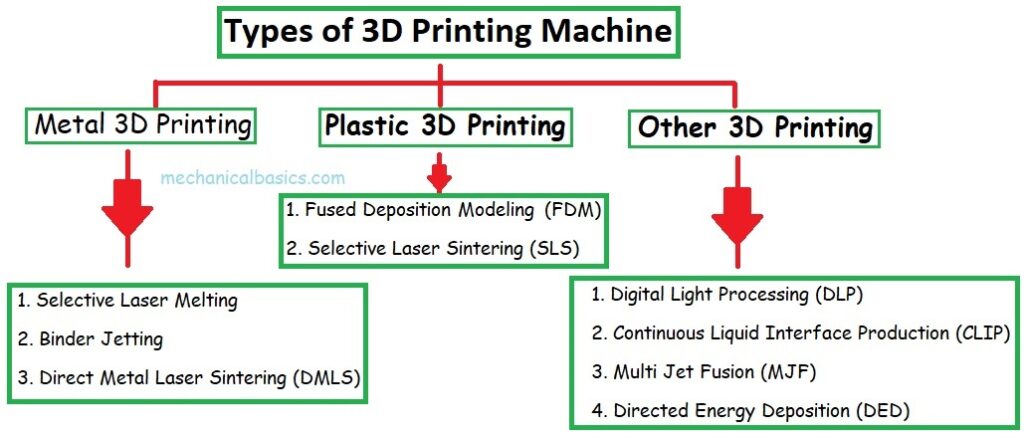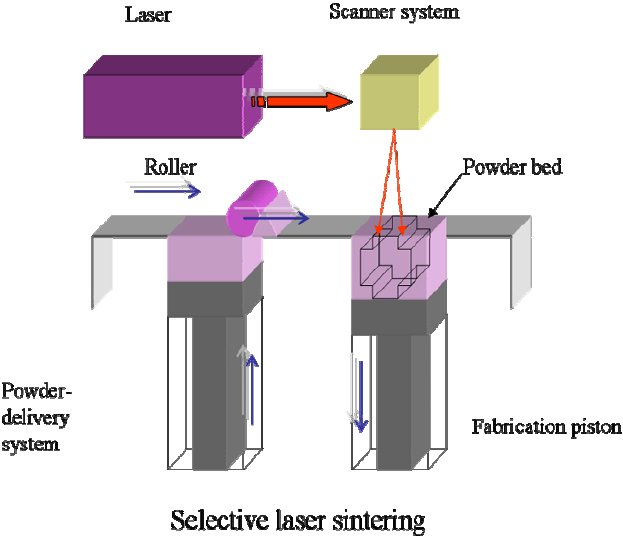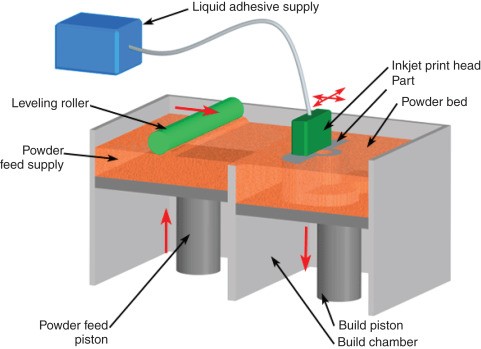What is 3D Printing Machine?
3D Printing, also called as Additive Manufacturing or Additive Manufacturing Process. The machine that manufacture or convert a raw material into required three dimensional object is called as 3D Printing Machine, which is also called as Additive Manufacturing Machine. There are different types of 3D printing machine, generally uses Fused Deposition Modeling (FDM), and continuous Thermoplastic Material Filament to produce precise customized components. Moreover, a 3D Printing Machine uses a layering process of Computer-Aided Design (CAD) to build three-dimensional solid items from a digital file, which is called as Input. This also involves stacking materials such as plastics, composites, or bio-materials to make items that vary in shape, size, stiffness, and colour.
Read More About 3D Printing Machine, its advantages, Disadvantages, and Applications
Types of 3D Printing Machine Techniques

There are several types of 3d printing machine or techniques based on the size, intricacy, and scope of a project. The way an object is produced will vary slightly depending on the type of printer used. The types of 3d printing machine techniques are as follows
- Metal 3D Printing Techniques
- Selective Laser Melting
- Binder Jetting
- Direct Metal Laser Sintering (DMLS)
- Plastic 3D Printing Techniques
- Fused Deposition Modelling (FDM)
- Selective Laser Sintering (SLS)
- Other 3D Printing Techniques
- Digital Light Processing (DLP)
- Continuous Liquid Interface Production (CLIP)
- Multi Jet Fusion (MJF)
- Directed Energy Deposition (DED)
Metal 3D Printing Techniques
The Metal 3D Printing Technique is one of the types of 3D printing machine techniques, which is further divided in to 3 types. They are
- Selective Laser Melting (SLM)
- Binder Jetting
- Direct Metal Laser Sintering
Let us read about these Types of Metal 3D Printing Techniques in detail.
Selective Laser Melting (SLM)

Selective Laser Melting (shortly called as SLM) is a technique of creating things additively by fusing metal powder particles in a complete melting process. The metal object will be built layer by layer, according to your 3D model, using this Selective Laser Melting method, as with other additive manufacturing processes.
In order to produce the ideal circumstances for the melting process, the 3D printer’s build chamber is filled with an inert gas (either argon or nitrogen at oxygen levels below 500 parts per million). Indeed, unlike Direct Metal Laser Sintering, and Selective Laser Melting; it completely melts the powder, necessitating a greater temperature than this other metal 3D printing technology. This method permits the metal to create a strong, uniform block.
Binder Jetting

Binder Jetting is one of the types of Metal 3D printing machine makes use of a powder base material that is uniformly coated with a liquid binder that is delivered through jet nozzles to function as an adhesive for the powder particles. It is an additive manufacturing technology that also produces metal parts. A binding agent is used in this method. This liquid binding agent is put onto granules based on a 3 dimensional file that user wish to create. Between each layer, the powder is softly cured to allow for solidification. Once the printing is finished, the build box is taken from the printer and placed in an oven to cure.
After the process is complete, the components are taken from the build box and the residual powder is removed using brushes and air blowers.
Direct Metal Laser Sintering (DMLS)
Direct Metal Laser Sintering is a 3D printing process that creates objects additively by sintering tiny metal powder particles and fusing them together locally. The main difference between this method and the SLS procedure we examined earlier is the sintering temperature. Indeed, polyamide must be sintered at temperatures ranging from 160°C to 200°C, whereas metal melts at temperatures ranging from 1510°C to 1600°C, necessitating the use of a higher-wattage laser to achieve that temperature.
A roller will apply a layer of metal powder, followed by the laser sintering the powder and lowering the build platform before adding a fresh layer of powder. The procedure is continued until the required 3D component is produced! The 3D printed items must cool after they have been completed.
Plastic 3D Printing Techniques
The Plastic 3D Printing Techniques is further divided into
- Fused Deposition Modelling (FDM)
- Selective Laser Sintering
Let us read about these Types of Plastic 3D Printing Techniques in detail.
Fused Deposition Modeling (FDM)

Fused Deposition Modeling (shortly called as FDM) also known as Fused Filament Fabrication (FFF) is a technique that involves unwinding a plastic filament from a spool and directing it through a heated nozzle in horizontal and vertical directions, producing the item as the molten material solidifies. This additive manufacturing technology is becoming popular among amateurs and educators. Usually, deposition of 3D printing elements is possible due to one or two print heads on the 3D machine.
This 3D printer works by melting and extruding material via a nozzle to 3D print a cross-section of an item one layer at a time. ABS and PLA, a bioplastic, are the most commonly used 3D printing materials with FDM technology. These are the materials that are commonly utilized in this technique.
Because personal 3D printers are less expensive than industrial types of 3D printing machine, Fused Deposition Modeling might be an excellent alternative for developing your own concepts.
Selective Laser Sintering (SLS)
Selective Laser Sintering (shortly called as SLS) a kind of Powder Bed Fusion, fuses microscopic particles of powder using a high-power laser to generate a three-dimensional shape. The laser scans and selectively fuses each layer on a powder bed before lowering the powder bed by one thickness and repeating the process till completion. This 3D printing process is ideal for creating complicated shapes or interconnecting pieces.
Let us read what is the operation of an SLS printer?
By sintering the powder layer by layer, this plastic 3D printing technology produces 3D printed items. The layer of powder is warmed close to melting temperature before a laser sinter the powder in accordance with the 3D file. Layer by layer, the laser sinters the powder to form a solid object. Polyamide must be sintered at temperatures ranging from 160°C to 200°C.
Other 3D Printing Techniques
Additional to Metal and Plastic 3D Printing Techniques, there are few other 3D Printing Techniques like
- Digital Light Processing (DLP)
- Continuous Liquid Interface Production (CLIP)
- Multi-Jet Fusion (MJF)
- Sheet Lamination
- Direct Energy Deposition
Let us read about these other Types of 3D Printing Techniques in detail.
Digital Light Processing (DLP)
Digital Light Processing (shortly called as DLP) is among the most traditional types of printing technology. Since the layers dry in seconds, DLP printing may generate prints at a faster rate than SLA manufacturing.
Continuous Liquid Interface Production (CLIP)
Continuous Liquid Interface Production (shortly called as CLIP) is one of the quicker Vat Photo-polymerization techniques. CLIP technology is used to project a succession of UV pictures over a cross-section of a 3D printed item, resulting in a perfectly controlled curing process. After that, the item is baked in a thermal bath or oven, which causes multiple chemical processes that allow the part to solidify.
Multi-Jet Fusion (MJF)
Multi-Jet Fusion (shortly called as MJF)a type of Powder Bed Fusion, uses a brushing arm to drop powder and an inkjet-equipped arm to selectively apply compound on top. For accuracy, a refining reagent is then placed around the detailing agent. Finally, thermal energy is used to initiate a chemical reaction. This identical procedure is used in Direct Metal Laser Sintering (DMLS), but uses metal powder.
Sheet lamination
Sheet Lamination joins layers of material together with external force and welds them together by multilayer ultrasonic welding. The sheets are again machined on a CNC machine to make the shape of the product.
Directed Energy Deposition (DED)
Directed Energy Deposition (shortly called as DED) is a metal industrial technique that uses a 3D printing device coupled to a multi-axis robotic arm with a nozzle for dispensing metal powder. The powder is applied to a surface and an energy source, which melts the substance and solidifies it.
Material jetting layer’s droplets of material through a tiny diameter nozzle to create a platform that is hardened by UV radiation.
Conclusion:
As 3D printers grow more inexpensive, they will eventually be employed for local, small-scale production, obviating the need for many forms of supply networks. Consumer units for home usage will even be possible, allowing end customers to simply download and print a design for the product they desire.
The traditional manufacturing industry will have significant hurdles in adapting to these developments. However, the prospects for science and engineering are certainly enormous, as are the creative possibilities in product design and printing material formulation.